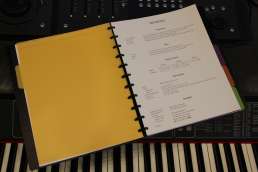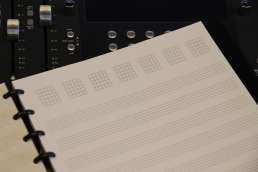Remember my “couture” songwriting notebook? Of course you don’t. But trust me when I tell you it was the height of fashion in 2018 – at least, until drop-crotch pants crushed it. F*#king Bieber.
But a lot has been learned since then. Some field-testing was done. Some books were read. Many redesigns were … uh, re-designed. Many fruit flies were made uncomfortable (but not harmed). Many Bothans died.
Now, thanks to 2020 being generally merde (or “craptastic,” if you’re an optimist), I’ve found time to incorporate those experiences into a newer, better, stronger, faster songwriting notebook. It’s the “mecha” version, with the stain-fighting power of Borax. And a new lemon-fresh scent.
What’s New?
This version of my DIY songwriting notebook incorporates a slightly modified workflow and, for off-the-rack mass appeal, includes three types of optional music notation worksheets, all wrapped up in a single Adobe Acrobat document with fillable form fields for personalization. No more jerking around with native CorelDRAW or Illustrator docs just to get your contact info and copyright statements correct.
The worksheet layout has been expanded from two to four pages per song, such that no two (or three) projects share the same sheets of paper, a serious flaw in my original design. Furthermore, the second sheet of each song section is dedicated to lyrics, front and back. This affords more immediate songwriting real estate while also allowing additional Lyrics worksheets to be added when a song outgrows its four-page sandbox. Importantly, this flexibility encourages, rather than discourages, rewrites. In fact, I’ve come to appreciate this flexibility so often that I now keep a stash of extra Lyrics worksheets behind a dedicated tab in my notebook.
Worksheet margins are now populated with reminders to consider all of your senses, perspectives, tense, and rhyme types while writing. Not to worry, I don’t believe the workspace has become cluttered and I was careful to employ impassive terms that won’t command too much attention nor derail your creative direction. I hope you find it helpful without being too distracting.
A new Reference section shares some valuable songwriting principles I’ve absorbed from experts in songcraft, including Berklee College of Music’s Pat Pattison and Andrea Stolpe, to name just two.
Gone is the Media column. In practice, it wasn’t practical – is that redundant or merely alliterative? – and consumed an unfortunate volume of Lyrics worksheet real estate. Instead, I simply scribble, “Melody on iPhone,” for example, and deal with tracking down the audio recording later, when I’m not juggling train tickets, cameras, backpacks, and songwriting notebooks.
Notebook Construction
To recap, this DIY songwriting notebook is designed for the travel-friendly DiscBound binding system. Check out my prior article, “Practical Couture – The Songwriting Notebook,” for details and a list of items you’ll need from your local office supply store. The worksheets might be compatible with traditional loose-leaf and other impermanent binding systems too, but I don’t recommend hauling those on your next songwriting journey up Mount Hua Shan.
When printing the worksheets, I suggest you divide the work into multiple print jobs to avoid confusion that can waste your expensive résumé paper. [You’re not composing your songs on plain ol’ copy paper, are you?!] For example, you wouldn’t want ten copies of the Cover Sheet or Reference page. I’m not saying I’ve ever done that – it’s just something to watch out for. You. Not me.
The Worksheets
Here’s a breakdown of the new songwriting notebook’s worksheets and sections, and how to use them:
Cover Sheet
For your protection, a bold cover sheet stabs your contact info into the unsuspecting eyeballs of the good Samaritan who finds your notebook orphaned in the airport lounge. You can apologize for the assault when your notebook is returned safe and sound.
New to this version, when you complete the form fields on the Cover Sheet – don’t forget the copyright statement at the bottom – all subsequent pages will be automatically populated with email address, mobile phone, and copyright statement in their footers. So, if the wind blows a page away, your rights are protected from the legions of songwriting trolls who would gleefully publish your work as their own. Or, maybe your page will be returned to you. By a stunning blonde who has a thing for songwriters. And a bag of magic beans. Don’t laugh. It happens more often than you’d think.
Title & Date
These are self-explanatory, though I’ll clarify that three lines are supplied for the title because it so often changes.
Inspiration
Use this section to capture the moment of inspiration – the environment, the mood, the physical sensations – or perhaps something more mundane – a conversation, a film, artwork, a particularly delicious (or awful) bowl of noodles, etc.
Be thorough! Inspiration is fleeting – especially two days later in a crappy hotel room with three smelly bandmates. Every word you record here will help to recover the moment that sparked your creativity in the first place. It may also produce some good, solid words for the Free Association and Rhymes sections, described below.
Refer to the inside margin for a list of physical senses to consider when your awareness needs a kick in the ribs.
Purpose
What is the purpose of your song? To inform? Persuade? Amuse? Spell it out here (in more detail than that) and you might enjoy a more productive songwriting session.
Admittedly, I sometimes leave this section blank until I find myself wandering in circles, fumbling for a second verse, a chorus, or a title. Or all of the above. Well, remember this: It’s hard to get where you’re going if you don’t know the destination.
As I’ve said before, I usually think of this as the song’s “call to action,” to borrow from the marketing department’s dictionary. As with the Inspiration exercise, describing the song’s purpose can also pull useful words and phrases from your subconscious, for the Free Association and Rhymes sections, coming up next.
Free Association
This section is for no-holds-barred, stream-of-consciousness, Jackson-Pollock-style word-barfing. Give yourself a couple minutes and a timer. Anything and everything that pops into your brain goes here. Everything! If those dark thoughts threaten to embarrass you or land you in jail, simply promise yourself to redact the naughty bits later, when the exercise is over. Otherwise, your ego (arch enemy of creativity) will remain in control and your efforts will be sorely handicapped.
Rhymes
Go back to the first page and highlight the best, most powerful words and phrases from the Inspiration, Purpose, and especially the Free Association sections. Carry the best eight to 12 words to the tops of the columns. Now, with your rhyming dictionary, determine and record up to 12 good, relevant rhymes beneath each word.
When choosing rhymes, consider the rhyme types that will serve your song best – that is, those that create tension and relief at the appropriate moments, beyond what is conveyed by the words themselves. This is prosody. Refer to the inside margin for a list of rhyme types, arranged from most stable to least stable. If the songwriting concepts of prosody and stability are unfamiliar to you, I recommend Pat Pattison’s book, “Writing Better Lyrics: The Essential Guide to Powerful Songwriting.”
For those songwriters who prefer “divine inspiration” to such methodical workflows, know that there’s nothing forcing you to use the rhymes discovered in this exercise. In my experience, it only augments those free-form efforts (and usually outperforms them).
Circle the very best rhymes.
Lyrics
Write your song here. Yeah. “D’uh.”
Ideally, your Rhymes worksheet produced a killer verse or two, and maybe even a chorus and title. Follow the trail until it ends and then, if you’re stuck for more verses, or maybe a bridge, return to the Rhymes worksheet with any new words you’ve come up with and fill in some of the unused columns. If those wash out, you’re on your own, but hopefully without too much divine intervention or vision questing needed to finish. [Kids, don’t do drugs.]
And by “finish,” we of course mean, “finish the first draft.” Now, it’s time to rewrite. Again and again. You know the high-intensity interval training drill. If you’ve populated your songwriting notebook with extra Lyrics worksheets, as suggested above, you can extend this song’s workspace indefinitely. Go nuts.
When writing (and forever rewriting) your song lyrics, consider tense and perspective. Refer to the inside margin for reference, and experiment to see which combination tells your story best.
Music Notation
Optional worksheets are supplied for those who like to write music using standard notation. All sheets are double-sided so you can easily add and move them, or omit them from your notebook altogether.
If you choose to use this or any of the other Music Notation worksheets, I recommend keeping a stash of extra worksheets at the back of your notebook.
Music Notation with Guitar Fretboards
A variation of the aforementioned Music Notation worksheet offers guitar fretboards at top. Go ahead and scribble in your drop-D B7#add23(No17), like nobody’s watching.
Guitar Tablature
Likewise, optional worksheets are supplied for those who prefer guitar tablature. [Hide all you like. We will find you.]
Reference
I forget things. Lots of things. So, this version of the songwriting notebook introduces a reference section, with shorthand hints and examples designed to reanimate a disremembered education in as few words as possible.
The Runway Ahead
This DIY songwriting notebook project will continue to evolve. I already have some additions planned for the reference section (e.g., a guitar chord chart), and maybe some music notation pages for bass and ukelele. Other suggestions are welcome.
Likewise, if you find the notebook useful, please introduce yourself in the comments below.
Download
Here’s the Acrobat file. Feel free to re-share, following a Creative Commons Attribution-NonCommercial-NoDerivatives 4.0 International License. For commercial use, contact me. I’m super easy.
| Document | File Format | Download |
|---|---|---|
| Songwriting Notebook v3.0 |
Adobe Acrobat (.PDF) | download |
Enjoy!







